
The one time I am truly glad that cats have a WAY more discerning palate for food than dogs is when it comes to human foods.
Most cats won’t gobble up people food ravenously like dogs, and most cats will even turn their noses at foods that would cause a dog to sacrifice a limb in exchange for a nibble.
But that doesn’t mean cats will never partake in some human food, should the opportunity present itself.
There is enough misinformation about cats that many people accidentally give them foods they think are nutritious and delicious but, in actuality, might send their cat’s stomach for a whirl — or maybe worse.
The following foods are best if they’re avoided entirely. Some, and I've noted which ones, should ONLY be used as occasional treats for your cat.
1. Milk and Dairy Items
There are few images more quintessentially “cat” than a group of them gathered around a saucer of milk. If these pictures were a little more honest, they’d show the aftermath of upset stomachs and diarrhea. Because, despite the cliché, most cats, though not all, are not equipped to handle the lactose in dairy products.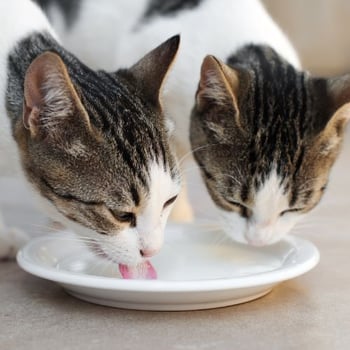
Lactose is the main sugar in milk. After cats are weaned, lactase, the enzyme that digests lactose, begins to disappear from the gut. Without this enzyme, cats are unable to digest lactose.
As lactose travels through the gastrointestinal tract undigested, it draws water with it. The lactose is then fermented by the bacteria in the colon, which causes the production of volatile fatty acids. This cascade of events can potentially lead to gastrointestinal upset (vomiting, diarrhea, nausea, gas, bloating).
Any milk or dairy product from cows, sheep, goats, and even other cats (after they’ve been weaned as kittens) can cause digestive issues since they contain lactose.
Note: Goat and sheep milk does contain less lactose than cow’s milk, but they both still contain it.
If your cat doesn’t appear to be lactose intolerant and you feel you MUST give your cat dairy, here are some dairy foods that tend to be low in lactose:
- Low lactose or lactose-free milk or butter
- Probiotic yogurt
- Hard, aged cheese (cheddar)
- Cottage cheese
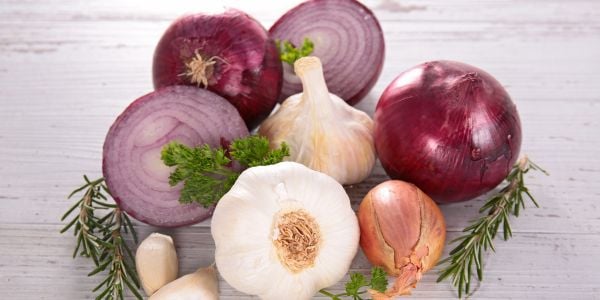
2. Onions and Garlic
Cats should not eat fresh, cooked, or dried versions of the genus Allium (onions, garlic, shallots, chives, or rakkyo). They have sulfur-containing oxidants, disulfides, and thiosulphates that are toxic to cats.
Cats are very sensitive to Allium toxicosis. When eaten, they cause oxidative damage to red blood cells. This can result in a devastating condition called Heinz body hemolytic anemia as well as the possibility of methemoglobinemia (red blood cells can’t properly deliver oxygen to the tissues). Secondary kidney disease can result from hemolysis.
Damage to red blood cells can occur if cats consume as little as 5 g of onions per kg of their weight. An even smaller amount of garlic ingestion is needed since they are 3 to 5 times more toxic than onions.
Symptoms of onion or garlic poisoning, which can appear quickly or take several days, include:
- Depression
- Lack of appetite
- Lack of coordination
- Lethargy or weakness
- Vomiting
- Diarrhea
- Excessive salivation
- Exercise intolerance
- Increased heart rate
- Increased respiratory rate
- Yellowing of the skin and gums
- Abnormal urine color (red to amber colored)
- Collapse
- Death
Sounds awful, right? The good news is that if caught early and aggressive treatment is provided to your cat by a veterinarian, there are usually no long-lasting effects. Delays in treatment can result in life-long health issues or even death.
Thankfully, most cats won’t go hunting for bits of onion or garlic, but they might take a few nibbles of your dinner that was cooked with onion and garlic or break into your bag of Doritos (or some other chip) and lick the chips (I know the latter from personal experience!). And then there's the risk of pet suffocation with the bag!
You may also give it to them inadvertently in chicken, other broths, soup, or baby foods that you might add to their food or water (either to encourage your cat to eat better, drink more, or just as a treat). It’s typically OK to give your cat a bit of chicken broth or baby food, but make sure it doesn’t include onions or garlic (or too much sodium).
If you suspect your cat may have consumed any of member of the Allium family of foods, contact a veterinarian immediately.
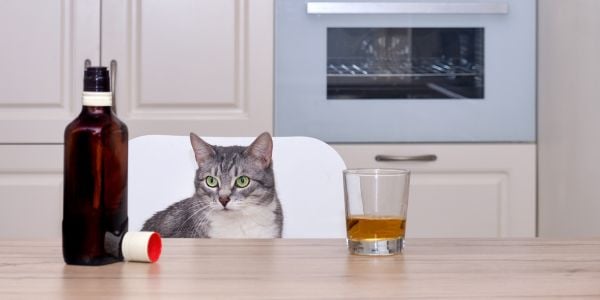
3. Alcohol
The alcohols most associated with poisoning in cats are ethanol, methanol, and isopropanol (isopropyl alcohol). Isopropanol and methanol are more toxic than ethanol.
Poisoning can occur via ingestion, absorption through the skin, or inhalation.
Products that contain ethanol include:
- All types of alcoholic beverages
- Certain rubbing alcohols
- Drug elixirs
- Alcohol-filled chocolates
- Food flavorings
- Fermenting bread dough
- Fermented fruits
Products that may contain methanol:
- Windshield washer fluid
- Varnishes
- Shellacs
- Paints
- Paint removers
- Adhesives
- Tobacco smoke
- Household cleaners and disinfectants
- Pesticides
- Canned fuels
- And more
Products that may contain isopropanol (isopropyl alcohol):
- Antifreeze (check out safer options to use in your car)
- Glass cleaners
- Jewelry cleaners
- Stain removers
- Household cleaners and disinfectants (check out pet-safer options)
- Hand sanitizers
- Beauty products
- Oral hygiene products
- Perfumes
- Alcohol-based flea sprays
- Some grooming sprays
- And more
Even small amounts of alcohol (after all, cats are pretty small) can cause a range of nasty symptoms if your cat is exposed:
- Incoordination
- Vomiting/diarrhea
- Sleepiness
- Digestive upset
- Breathing troubles
- Disorientation
- Excitement
- Excessive salivation
- Weakness
- Slowed breathing
- Seizures
- Increased heart rate
- vocalization
- Coma
- Death
Don’t leave drinks unguarded anywhere within a cat’s reach, and promptly clean any spills before your cat gets a chance to take a taste. With any product that may contain any type of alcohol, use caution when using it, and be sure to store it properly.
Seriously, it doesn’t take much more than a lick or two of alcohol to cause big problems in cats.

4. Chocolate
It’s not just dogs that have a problem with chocolate. Though less well-known, the theobromine and caffeine in chocolate can also be toxic to cats.
Cats absorb theobromine more slowly than people; therefore, even small amounts can be toxic, especially in smaller cats. Cats are much more sensitive to caffeine than people, so it can have significant stimulating effects.
The higher the level or percent of cocoa/cacao, the more toxic the chocolate is. For example, baker’s chocolate is more toxic than dark chocolate, which is more toxic than milk chocolate. For cats, the toxic dose of theobromine is 200mg/kg. Use can use this chocolate calculator to assess the toxicity risk to your cat.
It is helpful to know that white chocolate doesn’t contain theobromine or caffeine since it lacks cocoa solids. It still isn’t good for cats since it contains high amounts of sugar and fat, which cause their own issues (e.g., pancreatitis).
The symptoms of chocolate toxicity in cats include:
- Diarrhea
- Vomiting
- Increased thirst and urination
- Lack of appetite
- Elevated heart rate
- Hyperactivity
- Restlessness
- Panting
- Blood pressure drop
- Breathing issues
- Seizures
- Tremors
- Coma
Cats are less likely than dogs to chomp down a toxic dose of chocolate, but it’s still best to keep it away, especially darker chocolates that contain more cocoa.
If you suspect your cat ate chocolate, contact a veterinarian immediately.
Note: Some chocolate contains xylitol. Even though cats are not as sensitive to it as dogs, it is important to be aware of and inform your veterinarian if your cat consumes chocolate containing xylitol, even if it’s white chocolate. See our list of xylitol-containing products. There are over 700!
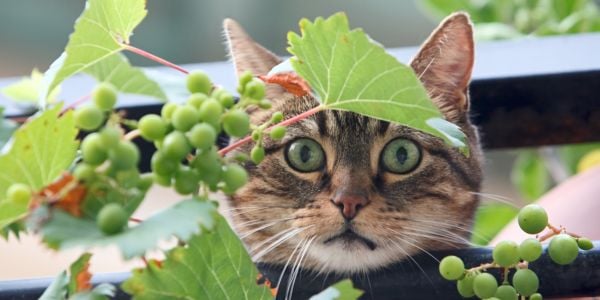
5. Grapes, Raisins, and Currants
We know for sure that these popular fruits can cause kidney damage or even life-threatening kidney failure in some dogs (the cause of toxicity is still unknown). And while the vast majority of toxicity cases involve dogs, there are reports of cats showing signs of toxicity to grapes and raisins.
While grapes are typically obvious when served, raisins and currants can be hidden in many food items we just don’t think about. They can be mixed up with nuts in a trail mix, in bread, in holiday fruitcake, cookies, bagels, or granola bars (this is especially cruel because they look like chocolate chips), and even in a liquid form like wine or juice. All of these presentations are very appealing to our pets.
Symptoms of grape, raisin, or currant toxicity your cat may experience include:
- Vomiting
- Lethargy
- Diarrhea
- Change in appetite
- Abdominal pain
- Changes in urination.
If you suspect your cat has eaten grapes, raisins, currants, or a food item containing any of them, contact a veterinarian immediately. The sooner your cat is treated, the better their chances for recovery and survival.
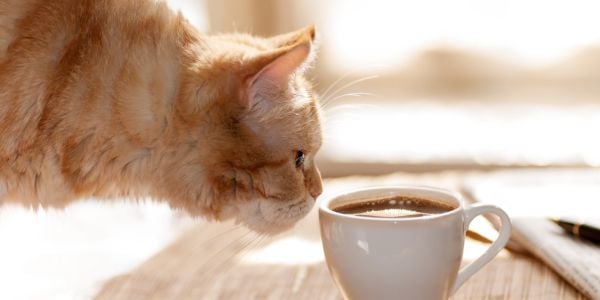
6. Caffeine
You might need a cup of coffee to get going in the morning, but the same amount of caffeine in your morning joe is more than enough to harm your cat. Cats are more sensitive to caffeine than people are.
It’s unlikely that a quick taste of your coffee, energy drink, or soda will cause severe issues for your cat. However, raw coffee grounds, coffee beans, and tea bags could contain enough caffeine to create a problem quickly, should your cat be so inclined to eat some. The ingestion of caffeine pills, even one, can be fatal for cats.
It is important to realize that even decaffeinated coffee contains some caffeine. And if you are inclined to have your decaf with lots of cream and sugar, your cat may find it appealing enough to take more than a sip, which could potentially cause some issues.
The toxic range of caffeine for cats is 80–150 mg/kg (36–68 mg/lb of weight).
Caffeine toxicity in cats can cause:
- Diarrhea
- Vomiting
- Hyperactivity
- Panting
- Excessive thirst
- Increased heart rate
- Tremors
- Breathing difficulties
- Seizures
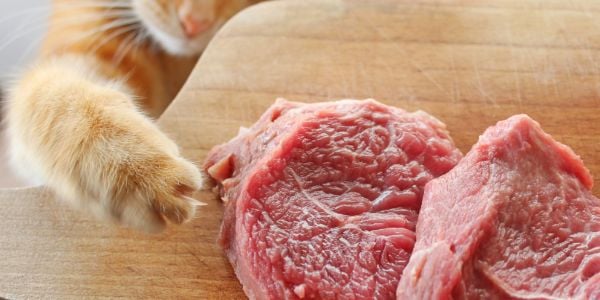
7. Raw Meat
It can be tempting to give your cat raw meat as a way of mimicking what they would eat “in the wild.” But just because a wild cat will eat raw meat, it doesn’t mean that raw meat is necessarily safe for your cat. Uncooked meat is more likely to contain harmful disease-causing bacteria (like Salmonella and E. coli, some of which could even be resistant to antibiotics!) and parasites (like Toxoplasma and even tapeworms).
Symptoms of salmonellosis in cats can include:
- Vomiting
- Diarrhea
- Fever
- Lack of appetite
- Lethargy
If you want to home-prepare your cat’s food or feed them a “less processed” diet, at least freeze and properly cook the meat to minimize the risks of giving your cat (and yourself) food poisoning or a parasitic infection. Be sure to properly clean and disinfect areas where raw meat came into contact as well as wash your hands well after handling the meat and utensils.
It is important to work with your veterinarian or a veterinary nutritionist to ensure that your cat’s diet has the correct nutrients, amino acids, vitamins, minerals, and other components — and that they’re in the proper amounts and balance, too.
It has become increasingly popular to feed cats raw diets. However, the variety of benefits is unsubstantiated, but the potential dangers to your cat and you are very real. This report released by the FDA, which worked with the Center for Veterinary Medicine, the Veterinary Laboratory Investigation and Response Network (CVM Vet-LIRN) as well as the Food Emergency Response Network, indicates the risks.
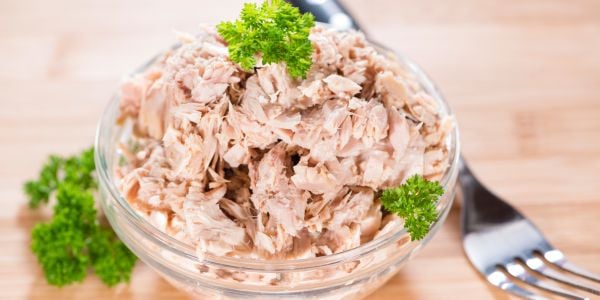
8. Tuna
As an occasional treat, cooked or canned tuna fish can be fine for cats. Read more about raw tuna in the next section. Its strong smell and intense flavor can often help to camouflage medication making the whole pilling process better for everyone. However, cats have complex dietary needs that tuna fish alone can’t fulfill. Furthermore, a strictly tuna fish diet — or a diet made mostly of tuna fish — can put your cat at risk of mercury poisoning.
Symptoms of mercury poisoning in cats include:
- Excitement
- Abnormal behavior and chewing
- Blindness
- Back leg rigidity
- Lack of coordination
- Tremors
If you give your cat tuna, only use the kind in natural spring water. Using tuna in oil or brine can contain too much salt and oil, causing other health issues.
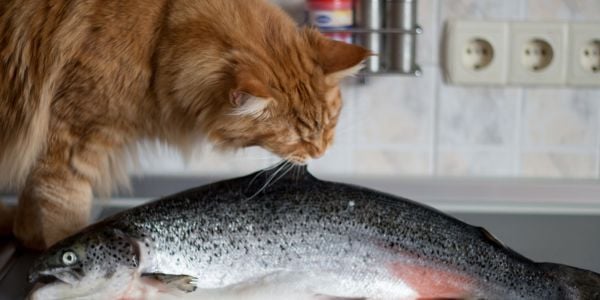
9. Raw Seafood
Raw tuna, anchovies (Caesar salad, anyone?), sardines, herring, carp, mussels, clams, and other water-dwelling critters contain thiaminase enzymes. They break down and can cause a deficiency of thiamine, an important B vitamin that is an essential component of energy metabolism for cats.
Deficiencies in thiamine can cause loss of appetite, weight loss, vomiting, and neurological issues (dilated pupils, vision issues, lack of coordination, tremors, seizures, and coma)
Fortunately, the heat from cooking these foods is enough to change the thiaminase enzymes and render them harmless.
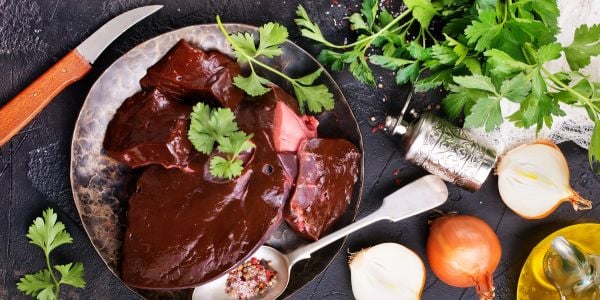
10. Liver (raw)
A bit of liver here or there isn’t a problem for most cats. In fact, liver can be a great source of protein, iron, and several other nutrients. But you can have too much of a good thing!
Liver is very high in vitamin A, and vitamin A is fat-soluble (builds up in fat cells within the body).
So a cat eating too much liver for too long can build up a dangerous imbalance of vitamin A — a condition called hypervitaminosis A.
Symptoms of hypervitaminosis A in cats include:
- Poor hair coat
- Rough or dry skin
- Neck stiffness
- Changes in bones
- Muscle soreness
- Lameness
- Weakness
- Lack of appetite
- Weight loss
- Constipation
- Painful or limited movement

11. Raw Dough
When eaten, the yeast contained in even a small amount of raw bread or pizza dough can quickly produce enough alcohol and carbon dioxide to cause serious problems for a cat. And the dough itself can “rise” (expand) within the cat’s stomach to a size that can require surgery to remove the digestive obstruction.
The amount of dough ingested affects the severity of the symptoms.
Symptoms your cat may exhibit after eating raw dough include:
- Disorientation
- Bloating
- Abnormal gait (walking like they're drunk)
- Symptoms of alcohol poisoning mentioned above (drunkenness, tremors, decreased respiratory rate, vomiting, decreased body temperature)
Time is of the essence if your cat consumes raw dough. Seek immediate veterinary care if you know or suspect your cat has eaten raw dough. With proper care, most cats recover within 12 to 24 hours.
Always be sure to keep raw dough that is rising securely away from your pets.
As an FYI, if your cat consumes just the packet of yeast that is used in making the bread, there is no need to worry since there is no source of sugar to cause it to ferment.
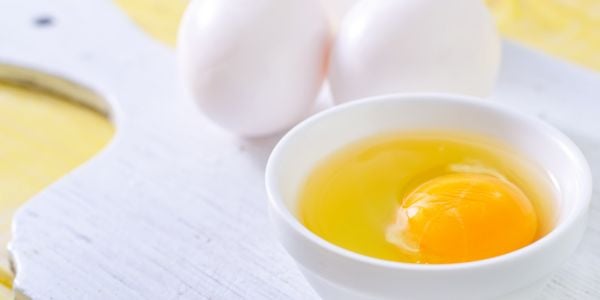
12. Raw Eggs
Along with the Salmonella risk that raw eggs can pose to cats, there’s also a protein in egg whites called avidin. When eaten raw, avidin can block the absorption of biotin, an important B vitamin, from the intestines. This can cause skin and coat problems.
However, cooking the egg whites changes the structure of avidin, rendering it harmless. If you're trying to think why anyone would give cooked eggs to a cat, it can sometimes be a component of home-cooked diets, e.g., for allergy/elimination trials or part of a bland diet regime when the cat has diarrhea.
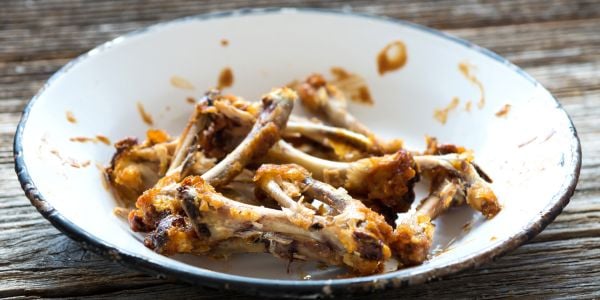
13. Bones
Small, brittle bones — like those in chicken, turkey, and other birds, as well as rib bones — can cause cats to choke, or they may splinter and cause serious damage, such as lodging in or puncturing the mouth and digestive tract of cats.
I know your first thought is cats eat mice and birds, and they contain bones. They can potentially cause harm just like any other bone. Some reasons that they aren’t as harmful is that the bones of mice and birds are very small in size as compared to the bones of full-sized chickens or the ribs of other animals. If they break in half, they are even smaller yet. Raw bones are typically softer, more flexible, and can be less dense than cooked bones, so there is a decreased likelihood of them splintering and puncturing. Lastly, a cat’s body is capable of digesting the meat and bones of these smaller prey in their raw state.
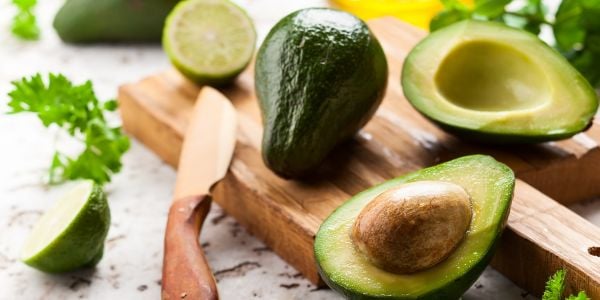
14. Avocado
Cats have been known to be attracted to the enticing smell of a ripe avocado. While this popular ‘good fat’ may be beneficial to people, the same can’t be said for cats. The high-fat content of avocadoes could cause pancreatitis in cats if they consume it.
Persin, an oil-soluble compound that is extremely toxic to cats, is contained in most parts of the avocado plant. While the edible fruit doesn’t contain the same high concentrations of persin as the leaves, it is still present and can cause toxic effects, especially consumed in significant amounts.
Symptoms of avocado poisoning in cats include:
- Vomiting
- Diarrhea
- Respiratory difficulties
- Heart issues
- In severe cases, death
See our list of safe fruits you can give your cat.
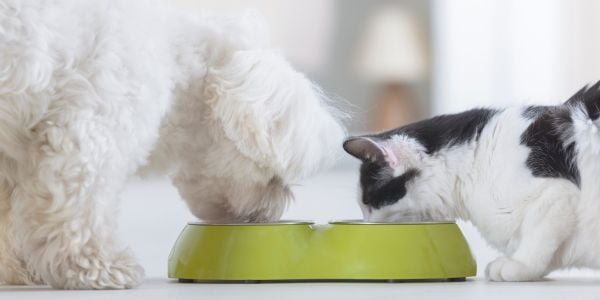
15. Dog Food
While the occasional nibble from Fido’s food bowl shouldn’t cause too much trouble for your kitty, a steady diet of dog food will.
Cats aren’t “small dogs” and therefore have different nutritional needs than dogs, such as a higher requirement for dietary taurine. This is an amino acid breakdown product that is critical in the proper health and function of the heart, eyes, and other organs.
Since dogs can create their own arachidonic acid, it isn’t added to their diets. Cats, on the other paw, can’t produce this essential fatty acid themselves and need it from their food.
Also, cat kibble is generally smaller than dog kibble, especially large-breed dog food. The larger kibble size can be a potential choke hazard for cats.
Consuming too much dog food in addition to their cat food can cause weight gain. Excessive weight can lead to other issues, such as diabetes or worsening arthritis.
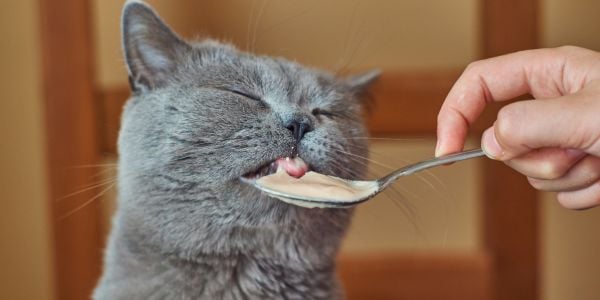
I cannot stress enough how important it is to always read food labels before giving anything to your cat. Additionally, always store food away safely and never leave food unattended. You never know what your cat may decide to try.
Are there any foods you’re concerned about feeding your cat? Ask about them in the comments, and we’ll do our best to answer.




